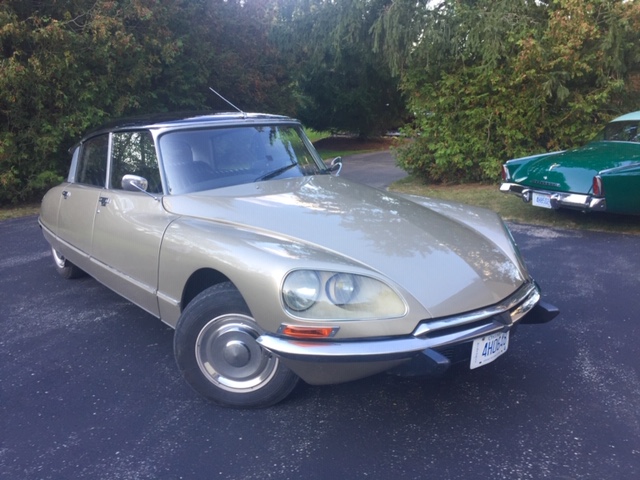
History of the 1973 Citroen DS23
Introduced in 1965, the Citroen DS1 is the 2,175cc, 109-hp variant of the famous Citroen DS. Its predecessor was the DS19 and it was replaced by the DS23 in 1973. The DS21 was offered in four-door sedan, two-door convertible, wagon, and “Pallas” luxury configurations. As before, the engine was upfront and it drove the front wheels. The transmission was a 4-speed semi-automatic.
The first DS23s utilized the same dramatic shape penned by Italian industrial designer Flaminio Bertoni almost a decade before. In 1968, the DS got a major facelift by Robert Operon. The revised DS21 introduced glazed driving lights that turned with the steering wheel, although American legislation prohibited these. Four exposed, fixed lights were used here instead. The engine also got a bump in power, and in 1969 power was raised again to 139hp with optional Bosch fuel injection. In the early ‘70s, fully automatic 4-speed and 5-speed manual gearboxes became available.
The Citroen DS23 has a hydro-pneumatic suspension system that raises the car when it is started. The original oil used for this suffered from being hygroscopic (readily absorbing moisture from the air) and 1967 saw a change to a more stable fluid called “LHM”. The seals between the two systems react badly to the incorrect oil, so the LHM is dyed green and parts are painted accordingly to avoid mistakes.
The DS23 was still primarily sold as a four-door sedan with the “Pallas” serving as the luxury model, but both a wagon and a convertible were available. The convertible model could be had with either factory “Cabriolet D’Usine” or privately-produced Chapron bodywork. The unique DS21 Presidential became the only car that Charles D’Gaulle would ride in after the car’s hydropneumatic suspension system played a large part in his escaping a 1962 assassination attempt.
As with the previous DS19, the DS21 had a less complex sibling in the ID21. This did away with the power steering and had conventional brakes in addition to a bit less power.
The Citroen DS does not reward hard driving driving but rather cossets with its sophisticated suspension to provide a comfy ride no matter what the state of the road surface. The only real letdown is under the hood, where the engine is derived from the prewar Traction Avant. The brakes are also quite sensitive, but they just take some getting used to.
Rust is the big enemy of the DS, particularly around the boot area, rear chassis and sills. The engines and gearboxes are robust with many refurbished major components available. The earlier hydraulic fluid should be replaced every 18 months.
The general rule with a DS is the later the car the better. Injected models fetch more than their carbureted equivalents, although they are relatively rare. The estate in turn is worth more than the saloon, but it’s the convertibles that are most desirable.
It is no coincidence that Citroen’s masterpiece sedan is called DS. It so happens that the French word for Goddess is Déesse, pronounced the same way as the name of Citroen’s new mid-sized sedan. The clever wordplay was more than just a marketing ploy; it was a fitting name for a car the likes of which had never been seen before. It’s stunning space-age body was designed by Flaminio Bertoni and André Lefèbvre; an Italian sculptor and French aeronautical engineer, respectively. Production ran from 1955-1975. Citroen attempted to redefine the limits of automobile design with their flamboyant new car. Under the spaceship skin was a thoroughly modern, highly sophisticated machine. The independent suspension was sprung by an advanced hydro-pneumatic system that was self-leveling and adjustable for ride height. Inboard front brakes reduced unsprung weight and the DS was the first car to feature power front disc brakes as standard. The high-pressure hydraulics controlled braking, and steering. You can even change a tire without a jack. The roof panel is made of fiberglass, lowering the center of gravity to help with handling. This 1973 DS23 features the redesigned front end with enclosed headlamps that swivel in conjunction with the steering. This model also is fitted with a conventional 5-speed manual transmission. Under the hood lies the 2.3-liter 4-cylinder engine The utterly fantastic single-spoke steering wheel gives a clear view of the original instruments and out over the long hood. The interior of the DS is like nothing else out there – the seats are like sitting on an overstuffed sofa as the suspension effortlessly soaks up bumps. The Pallas model has top-of-the-line leather interior and other luxury appointments. The Citroen DS was voted the most beautiful car of all time by Classic
& Sportscar and it also finished 3rd in the Car of the Century award.